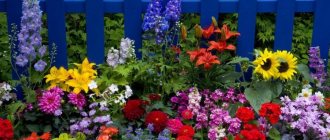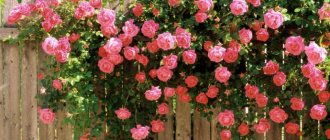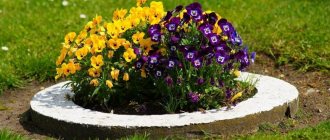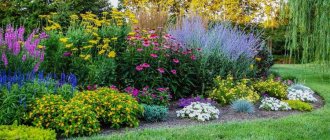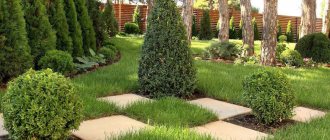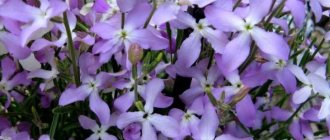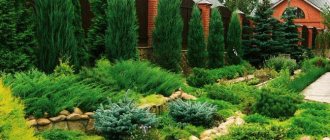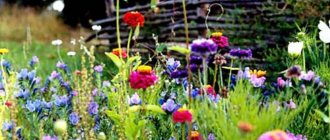A dacha plot with waterlogged or too damp soil is not yet a reason to install a powerful drainage system. In order not to disturb the natural landscape, it is enough to choose plants for planting that can easily tolerate such growing conditions. Among the moisture-loving crops there are perennials and annuals, decorative foliage and flowering ones. The most suitable are those that can decorate the site for many years. They are a group of plants that naturally grow in swamps, shallow waters, and near reservoirs, but can also be grown culturally, and, therefore, become an ideal choice for dachas where the land is waterlogged.
Swamp or "Pennsylvania" rose
A spreading shrub with an erect stem up to 2 m in height. It grows quite quickly and acquires young shoots. This rose comes from North America, where it grows on banks, swamps, ravines, and feels great both in partial shade and in bright sunlight. Belongs to highly ornamental crops. A Pennsylvania rose decorates a summer cottage. It looks especially impressive as an accent against the background of non-flowering, that is, decorative deciduous plantings. The thorny shoots are reddish-purple in color. The edges of the dark leaves are covered with teeth. Small flowers forming inflorescences adorn the “lace” crown. During the summer months, the color changes from pink to bright orange. The flowering period occurs in July-August. The moisture-loving culture requires care. Shrubs are annually removed from old branches and young shoots.
Iris
Swamp iris
Some types of irises prefer waterlogged and even flooded areas in the spring, the banks of reservoirs. Swamp iris (Iris pseudacorus) with bluish-green leaves is distinguished by a peduncle 70-80 cm high, on which there are 12-15 golden-yellow flowers. Their peculiarity is that the upper petals are underdeveloped; the lower petals have a large orange spot.
Iris smooth
Smooth iris (Iris laevigata) is so named because its leaves lack a pronounced central vein and form a loose bush. The spectacular flowers are characterized by an intense violet-blue color with a narrow golden-yellow spot (“eye”) on the lower petals. There are varieties with three- and six-petalled flowers of different colors (blue-violet, reddish-purple, white). A more moisture-loving species than marsh iris, when grown on the shore of a reservoir, over time it can move to a sufficiently large depth.
Iris bristles
The bristly iris (Iris setosa) is distinguished by the structure of the flower; the three upper petals in the process of evolution have turned into inconspicuous bristles. The color of the flowers is white, pale blue, violet-blue. An interesting feature of this species is that mature seed pods make noise like rattles in the wind.
Calamus marsh
It is found in swampy areas, near rivers and lakes, but is also grown in summer cottages. Calamus grows in fertile, flooded, muddy areas, but prefers open sunny spaces and looks great in a wetland. The decorative deciduous plant has long leaves of a bright green color with peculiar “frills” along the edges. To create a spectacular flower arrangement, calamus is planted next to its early-blooming neighbors that cover the curtains in early summer. On a summer cottage, it is best to plant a garden variety called Variegata. Its characteristic feature is cream and white stripes. The plant requires regular weeding and division of clumps if it grows excessively. Thanks to its unusual appearance and color, and relatively low height, calamus always looks neat and original; of course, if the plant is properly cared for, it becomes a wonderful decoration for a personal plot.
List of unpretentious flowers
Perennials
- Colchicum
- Crocuses
- Muscari
- Lilies of the valley
- Periwinkle
- Astilbe
- Aquilegia
- Geranium
- cornflower
- Loosestrife
- Garden chamomile
- Spiraea
- Phloxes
Annuals, biennials
- Marigold
- Nasturtium
- Cosmea
- Alyssum
- Calendula
- Viola
- Daisies
- Rudbeckia
- Petunias
- Phacelia
Water snake or marigold
A beautiful flowering perennial that tolerates damp and marshy soil well. Dense, round leaves cover the branched stems. They are quite large. The diameter of the plates reaches 12 cm. The plant is especially attractive during the flowering period. It falls in April-May. The color of the flowers is golden, which is quite unusual. “Water snake” looks most impressive as an accent. It decorates “raw” flower beds and other plantings formed at the dacha. There are different varieties of marigold. In cultural cultivation, the most valuable ones are Falve and Multipetal. Many gardeners prefer these varieties. The plant does not require any special care. Division is carried out every three or four years, depending on the degree of growth. Culture loves sunlight. Partial shade is also suitable. If trees are planted on the site, then it is better to plant marigold under those that do not have a too thick crown.
Sedum (sedum)
Sedums are succulent garden plants that accumulate moisture. In small ground cover plants that rise only 7–10 cm, beneficial substances accumulate in needle-shaped, fleshy leaves.
Sedum (sedum): YouTube/Euro-Plant
Thanks to its rapid growth, sedum covers the soil and retains remaining moisture. Some varieties have petals in the form of beautiful flowers. Ornamental plants throw out flower stalks, on which bright inflorescences with small flowers open.
Sedum is planted in different ways:
- cut cuttings from the middle of a healthy stem and plant them in loose soil for rooting;
- the bush is divided into several parts and divided into separate holes;
- Seedlings are grown from seeds in March–April.
Planting of sedums is carried out in May, having prepared a nutritious soil mixture in the flowerbed. To root sedum, use abundant watering.
Meadowsweet or meadowsweet
In nature it grows in swampy forests and water meadows. Similar conditions are necessary for the cultural cultivation of meadowsweet. In June it begins to bloom with white lush lace. The rest of the time, except for the flowering period, meadowsweet looks more modest. Thanks to its good hardiness and beautiful inflorescences, this moisture-loving plant is popular among gardeners. Meadowsweet mainly has white inflorescences, but there are also varieties with a pink color. The feathery foliage gives the plant special beauty, against the background of which the corymbose and paniculate inflorescences look truly majestic. The most popular among gardeners are elm-leaved and Korean meadowsweet. Caring for a decorative flowering moisture-loving plant comes down to cutting off wilted inflorescences, dividing and replanting the bushes every 5-6 years. Meadowsweet grows best in areas located in forested areas, near natural bodies of water. The shrub is a sun-loving crop, but adapts well to partial shade. Water the plant only when the soil dries out.
Lupine
The flowerbed will be decorated with drought-resistant perennial lupine flowers (“wolf beans”), blooming twice a season. A plant from the legume family is sown with seeds in May or autumn.
In the first year, only bushes with beautiful palmate leaves appear. Powerful flowering shrubs grow in 1.5–2 years if planted in islands.
Lupine: YouTube/Fun Gardening
Caring for lupine is not difficult:
- Plant bushes one by one or in groups in slightly acidic soil.
- The stems are cut off after flowering so that by autumn there will be new branches.
- Watering is carried out during the period of germination and rooting of seedlings.
- Mineral fertilizers are applied before flowering.
Lupine blooms in long racemes covered with irregularly shaped flowers. The length of the inflorescences reaches from 50 cm to 1 m. The flowers have different colors from white to purple. The flowerbed produces a unique mix of shades.
Euphorbia swamp
It differs from other representatives of the Euphorbiaceae family in its love for high humidity and dampness, growing in flooded meadows. Planted on the site, it tolerates short-term flooding well. This culture is an excellent background for decorative flowering shrubs and plants, designing ponds, and decorating flower beds on wet soils. The perennial plant has a large cylindrical rhizome and is unpretentious. The bare bluish shoots are covered with bright and narrow foliage. The inflorescences are not particularly decorative. When they fade, prune them to thicken the clumps. Rejuvenation of swamp milkweed by removing the aerial parts is carried out every 3-4 years. For a culture to develop normally, it needs light and moist soil. If tall varieties are grown, then supports are installed.
Spirea
The perennial spirea shrub looks beautiful on large flower beds and lawns. A deciduous plant from the rose family, the color of the inflorescences ranges from snow-white to crimson.
There are about 100 species of shrubs. There are early-blooming and late-blooming perennial varieties that bloom in summer.
Spiraea: YouTube/ Hitsad TV
Shrubs of various types grow from 15 cm to 2.5 m, spreading lush branches in all directions. Spiraea inflorescences are made up of small flowers and acquire a spicate, corymbose, paniculate or pyramidal shape. Flowers can be placed along the entire stem or collected at the very end of the branch.
Spiraea reproduces by dividing the bush, layering, cuttings and even seeds. Dwarf bushes are planted to decorate borders, and drought-resistant giant plants are excellent for hedges. Spirea loves sunny areas, does not require additional watering, and tolerates winter well.
Loosestrife
It is a perennial with straight shoots forming clumps with a height of 70 to 80 centimeters. Refers to light-loving but shade-tolerant crops. If there is enough light, it quickly grows into a large clump (shrub). The plant tolerates severe cold well and does not require shelter. It has a powerful shallow root system. So that it does not “capture” a large area, and the flower garden looks beautiful and well-groomed, excess parts are regularly removed. Creeping varieties require strict growth control, while erect varieties require removal of inflorescences and hilling. When deciding to plant loosestrife, you should keep in mind that it grows best in moderate humidity, but also adapts to waterlogged soil. Loosestrife blooms from May to August. The bush produces inflorescences of white, pink and pale yellow colors. To achieve repeated and more abundant flowering, faded inflorescences must be trimmed.
How to create beauty in your dacha
We come to the dacha not only to dig in the soil, but also to admire the beautiful, bright landscape. Beautiful perennials will help create multicolor. Why do they attract gardeners? They are not as difficult to care for as annuals. In addition, you can create an excellent “picture” by choosing the right crops based on growth and flowering time.
Summer residents want to see flowering flower beds in early spring. The best option for early flowers may be crocuses. The snow has not yet melted, but crocus buds are already illuminating the garden with a rainbow of colors.
Crocuses
The plants are low-growing, only 7 to 15 cm tall, but, blooming in March, they will bloom until May. After wilting, the tubers of the flowers go to rest and wait for spring.
Bulbs should be planted throughout August and September. They need little space. You can even plant it under trees that have not yet bloomed their leaves or on a stone hill.
Muscari
This is a very unpretentious plant. It blooms in April, then “rings” with blue bells until the end of May. The flowers are also short, only 10-20 centimeters.
Once planted under garden trees, you can admire the blue-blue bells for 6-7 years. There is no need to seat them, they themselves will take up as much space as you allow them.
Muscari are convenient because they go well with flowers of any shade and require virtually no care.
Pushkinia
You will be enchanted to see the blue, white or blue inflorescences of Pushkinia, which begin to bloom in April. Their bright colors will delight you until May.
Tulips
Tulips for the garden are the best perennial, because by choosing different varieties, you can admire the bright buds from March until early June. The height of tulips is 10-50 centimeters. Due to this difference in height, they will look good on a hill and high flower beds.
Bulbs should be planted in September in sunny areas. They love watering and fertilizing. After drying, there is no need to water.
In the northern regions, the varieties Greig, Gesner and Foster are usually planted, but they must be dug up for the winter. But the Kaufman variety will withstand any frost.
Daffodils
Daffodils are also a favorite flower of many gardeners. Unpretentious plants can bloom in one place for many years. They go well with all garden flowers, but when they fade, they leave behind not very beautiful foliage. To hide it, you can plant peonies and perennial poppies nearby.
Periwinkle
Periwinkle is good because it blooms for a long time even in the shade. It itself spreads quickly under the canopies of garden trees.
Dicentra
Dicentra buds look like small hearts, so they have another name - “broken heart”. The spectacular plant can grow up to 1 meter in height and become covered with white and pink inflorescences already in May.
Flowering lasts about a month, and after it fades, its foliage will become a wonderful backdrop for other inhabitants of the flowerbed. Primrose, narcissus, muscari, and fern can become its neighbors.
Lily of the valley
Lilies of the valley are good because when they bloom, they become covered with red berries. This plant has beautiful leaves and delicate flowers, so they look good in any flower bed and can also grow in the shade.
Brunner
If there is a pond at the dacha, then Brunnera will decorate it perfectly. Easily tolerates shady areas. It retains its decorative appearance for a long time and grows in one place for many years.
Thyroid darmera
A perennial herbaceous, moisture-loving plant with large leaves, like loosestrife, tolerates winter well. It has a thick, powerful and knotty root with a diameter of 6 cm, which does not produce underground shoots. The crop is perfect for planting in wetlands and forming a “damp” flower bed. Leaves with grooves and veins give the shrub a decorative appearance. Purple spots and streaks appear on the plates. The inflorescences bloom in April-May, before the leaves appear. Soft pink flowers on unusual purple stems look especially bright and beautiful. The best soil for growing darmera is one where the level of waterlogging is variable. The culture is not light-loving. She loves partial shade. When the bush grows excessively, division is carried out. Peduncles should be trimmed and fertilized in the spring. The most decorative variety of loosestrife is “Nanum”, which grows up to 50 cm.
Ostrich
Common ostrich
One of the most resilient and attractive ferns for planting in wet areas is the common ostrich fern (Matteuccia struthiopteris). This is a large plant with feathery leaves that form a cup 100-120 cm high. The plant is unpretentious, grows both in the sun and in shaded areas, on poor and fertile soils, but always requires moist soil.
Young leaves of the common ostrich
The ostrich is attractive all season, from the moment the leaves appear, which unwind in early May, resembling some exotic creatures, until the first frost. It reproduces by cuttings of rhizomes, tolerates replanting well, does not suffer from frost, grows quickly, the rhizome grows by 20-25 cm annually. It looks impressive both as a thicket and in combination with other plants.
Himalayan honeysuckle
A moisture-loving and unpretentious shrub. The plant does not require any special care. It is quite easy to grow. The culture has arched branches, against the green background of which the purple inflorescences look quite impressive. Himalayan honeysuckle looks best against the background of white turf and near ponds, in the surface of which the shoots of bushes are reflected.
Conifers for wet soils
Coniferous plants that can withstand excessive soil moisture include swamp cypress.
Swamp cypress, or taxodium birow
The needles of the swamp cypress turn red in the fall and fall off in the winter.
This plant is little known and is still rarely found in our gardens. Young specimens of swamp cypress (Taxodium distichum) are sensitive to frost, and plants 5-6 years old acquire good frost resistance. The crown of the cypress has the shape of a regular cone; in the fall, the light green soft needles turn bronze-burgundy and fall off, like those of larch. The exotic appearance of the tree is associated with the gardens of Mediterranean countries.
A characteristic unique feature of the swamp cypress is its pneumatophores, or breathing roots. They protrude vertically above the surface of the earth and resemble fantastic periscopes from the Harry Potter films. The plant is intended for planting in the coastal zone of reservoirs, streams, and ponds.
Aerial roots, or pneumatophores, are designed and act in such a way that swamp cypress can grow even in water
Metasequoia is the oldest
The relict (which existed in ancient geological eras) deciduous tree metasequoia is also considered ideal for planting in humid places. It is noteworthy that first fossilized imprints of pine needles were found and only then living trees preserved in the mountains of China were discovered and described. In appearance, metasequoia resembles its American relative, the swamp cypress. In its native China, it is called water larch because it grows around flooded rice fields.
Like larch, metasequoia sheds its needles along with small twigs in winter
The crown shape of metasequoia is regular, narrowly conical. Like its “brother” cypress, the plant’s needles are seasonal: new ones grow in the spring, and in the fall they turn a beautiful yellow-bronze hue. Metasequoia is characterized by fast growth and frost resistance, and tolerates pruning perfectly. Intended for planting as a protective fence, as well as for framing water bodies.
Canadian hemlock
Thuja folded, or giant, the popular western thuja (or tree of life) and Canadian hemlock (Tsuga canadensis) tolerate moist soil well. The latter deserves a more detailed description. This tree with evergreen needles is perfect for various types of fencing. Hemlock will perfectly play the role of a wide hedge, as it can be freely formed and trimmed.
It is not necessary to trim the thin and delicate branches of Canadian hemlock - the plant looks good both as a hedge and in a solitaire planting
However, hemlock can protect your area from prying eyes even without pruning, being in its “pristine” form. The tree will also perfectly fill open spaces and become a hedge from prying eyes. In a solitaire planting, hemlock attracts attention with its unusual appearance: thin hanging shoots, densely strewn with small needles, give this coniferous plant picturesque and charming.
Recommendations for growing moisture-loving shrubs and plants
Crops that tolerate moisture and dampness well have their own specific needs. They develop and grow best not on poor, but on nutrient-rich soils. Therefore, when growing such plants, they first reduce the acidity level and add a nutrient substrate. The soil must not be allowed to dry out. This is especially true in the summer, when there is practically no rain.
Most moisture-loving crops do not die during a short-term drought, but this possibility exists if watering is not provided in a timely manner. The best option is to plant plants near a body of water, for example, on the borders of the site on the side where the pond or lake is located, so that they act as a hedge. Along with shrubs, in dachas with waterlogged soil, it is recommended to plant trees - alder and willow. They decorate the site all year round.
Moisture in the soil causes the ground to freeze early. Therefore, it is not recommended to plant plants in late autumn. It is optimal to plant moisture-loving crops on such soils in the spring and in the first weeks of summer, while the soil has not yet warmed up.
Carnation
Carnations will become a real decoration of the garden all summer long. Dry-loving plants bloom for a long time and are unpretentious to soil and watering.
Flowers have different sizes, shapes and shades. But most varieties of carnations bloom in bright red, pink or two-tone colors.
Carnation: YouTube/Everyone can do it!
They are grown as a perennial, but without renewal the bushes quickly age. Therefore, in the spring, carnations are sown with seeds in the flowerbed. In the first year, the plant develops leaves, and in the second year, flower stalks appear.
Cloves also reproduce in other ways:
- seedlings;
- dividing bushes;
- cuttings;
- rooting cuttings.
Thanks to the timely renewal of plants, a flower bed with carnations blooms every year.
How and why do we become dependent on the garden?
One of the reasons is the huge number of purchases made after viewing numerous catalogs, reading articles in floriculture magazines, advice from flower growers on specialized forums, and the delight of friends and acquaintances. Beautiful photographs and fascinating descriptions often give rise to one desire - to have a plant you like in a flower garden, in a school garden, or, finally, temporarily buried in a vegetable bed.
We make a huge number of purchases and strive to quickly fill empty space. Photo by the author Another reason is that the area is initially empty, which the beginner wants to quickly fill with decorative color spots and accents. Therefore, he plants fast-growing phalaris, variegata and yarrow, fills the voids with the most common varieties of daylily, irises, fragrant violets, cypress spurge, point loosestrife and various sedums. So the rows of rootless irises and phlox, bought near the vegetable market, and flowers “from grandmothers” under the strange names “heels” and “eyelashes” are multiplying. In any case, this is how the story began on my dacha land. A novice florist rejoices in the self-sowing of buzulniks and geraniums, regretting every root or cutting formed during division, pruning or transplanting. The surplus is placed “in the backyard,” behind the barn, near the fence, in front of the fence, and distributed to neighbors and hobby friends. Grinding an extra bush in a shredder, throwing a piece into a fire or in the trash seems like a crime, especially for a woman with her reverent approach - “it’s alive!”
Popular articles 6 methods that will save you from weeds on garden paths
Beautiful low maintenance garden where to start
Do you want to create a beautiful low-maintenance garden or a garden for the lazy? Or a low-maintenance decorative garden, or a new garden? There are a great many ideas for creating and naming such a garden, and it doesn’t matter what they call it, the main thing is that such a garden is beautiful, well-groomed and does not take much time to maintain. The topic of creating such a garden is not new; the question of it is regularly raised in gardening literature, on the Internet on thematic sites, and on video channels
It’s even possible that some of you have already tried to arrange such a garden on your site, but something didn’t work out
The topic of creating such a garden is not new; the question of it is regularly raised in gardening literature, on the Internet on thematic websites, and on video channels. It is even possible that some of you have already tried to arrange such a garden on your site, but something did not work out.
We would like to warn you right away that creating such a garden without effort and a well-thought-out plan will not work. Moreover, every stage of creating such a garden is important.
In order to rest later, you must first try!
What is a low maintenance garden
Let’s try to figure it out, take into account the guru’s advice on this issue, in order to realize this dream of a “low-maintenance ornamental garden” on your site.
A beautiful garden for the lazy is a garden in which a golden mean is found between gardening chores and the pleasure of relaxing in nature, meeting with loved ones and friends away from the bustle of the city.
Most gardeners who come to their country plots only on weekends want to relax and communicate with family and friends. If you care for plants, do it with pleasure, and not through force. Do not waste time on garden work that never ends: weeding, watering, mowing, etc. But a bright, spectacular, well-groomed garden continues to be the dream of many gardeners. How to create a garden where there is time not only for endless work, but also for relaxation? Is it possible for gardening chores to be enjoyable?
We can reassure you: dreams of a beautiful, and at the same time unpretentious, garden can be realized.
Popular articles Features of landscape design of a site with a slope
Lawn size and shape
Another important note is that the size and shape of the lawn must be carefully thought out and calculated. Designed to fit the width of the lawn mower and without sharp corners
Then you won’t have to go through the lawn mower one more time or trim the “inconveniences” additionally using scissors. The best lawn mower is a petrol one and, of course, one with a grass catcher.
And don't put lights on the lawn! They are very inconvenient to mow.
Dear readers! I hope that my advice, gained from my own experience, will be useful to you. And even if you don’t make some of the mistakes when creating your garden, it means that I didn’t write this article in vain.
When might you need a designer's help?
The design of the garden can be done by a designer. He will assess the conditions of the location of the dacha, plan, select shrubs and trees, add indoor plants to pots, and advise on their care. In this case, even a swamp will become decorative, and an artificial reservoir will become a natural stream. By correctly selecting and arranging luxurious plants that are not afraid of damp places, even a problem area can be turned into a blooming, fragrant place that bears fruits and berries.
What to consider when choosing plants
The only thing that is taken into account when choosing plants is resistance to moisture, frost, low oxygen concentration in the ground, and the ability to withstand flooding . As practice shows, a site that cannot be landscaped in a standard way has all the conditions for creating bright, unusual areas and places for relaxation. The assortment of trees, shrubs, and plants is extensive; you can display indoor flowers in flowerpots. Therefore, areas with high humidity are a chance to create unique decorative compositions, and with some effort you will get good harvests of berries and fruits.
- Author: Maria Sukhorukikh
Rate this article:
- 5
- 4
- 3
- 2
- 1
(0 votes, average: 0 out of 5)
Share with your friends!
Requirements for plants for waterlogged areas
The main requirements for such plants are a love for a high level of moisture and a fear of flooding and stagnation of moisture in the soil. They must be able to withstand low oxygen concentrations in the soil and be able to withstand flooding and getting wet. But sufficient endurance and resistance to frost are equally important. After all, soil saturated with moisture creates specific and more severe conditions, freezing earlier than ordinary garden soil, and thawing much later.
Lysichiton in the design of a waterlogged area. © Kathryn Mezger
Crops that can settle in waterlogged, swampy areas in the garden are very different. They are conventionally divided into:
- decorative deciduous, the flowering of which is rather inconspicuous;
- beautifully flowering (but their foliage is also always quite attractive).
You can find your moisture-loving stars among perennials and even among annuals. But most crops are still classified either as giants (trees and shrubs from viburnum to hydrangea and maples), or as herbaceous perennials that will decorate such areas for decades.
Plants that can grow in damp areas are suitable for decorating various water bodies and prefer to settle in shallow water or in swamps. But there are also plants that are more often used in decorative swamps or wet flower beds, and not in reservoirs. Wet flower beds, although rare, are becoming increasingly widespread and help solve problems without drastic measures and significant funds.
Reasonable compromise
So what remains? Arrange a wide mixborder along a well-lit fence and feel free to include ornamental shrubs in it. An ideal addition to them would be daylilies, hosts and astilbes.
These plants are quite unpretentious, do not require frequent division, do not get sick and grow prettier year after year. The hosts will be especially pleased. But we need to find a place where they will feel comfortable. However, if you can’t imagine a garden without lush blooming peonies or the intoxicating aroma of roses, be sure to plant them.
At the end of the day, what counts as bereavement and what doesn’t is up to you to decide. As for vertical gardening, virgin grapes or honeysuckle honeysuckle would be a reasonable replacement for tender clematis. They will no less effectively decorate the wall of a house, gazebo, veranda or pergola, but will not require so much work.
Lawn without hassle
The lawn is not a pleasure for the lazy.
Properly preparing the soil for a lawn requires a lot of time, effort and patience. But in the future, the lawn will require systematic care. You will have to cut it every week, especially in rainy summers when the grass grows back very quickly.
And you will also have to constantly fight with dandelions - no matter how much you mow them, they grow back again and again. In general, you should think carefully about whether you need this headache? An alternative would be a clover lawn. Only you need to sow not pink clover, but white. It is not tall, does not lie down, creates a dense turf, does not get trampled and winters well.
